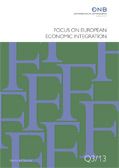Focus on European Economic Integration Q3/16
 OeNB
OeNB
- Erschienen:
- September 2016
 OeNB
OeNB
Focus on European Economic Integration Q3/16 (PDF, 2,7 MB) September 2016
Call for entries: Olga Radzyner Award 2016 (PDF, 50 kB) 05.09.2016, 00:00:00
Call for applications: Visiting Research Program (PDF, 50 kB) 05.09.2016, 00:00:00
The development of bank profitability in Denmark, Sweden and Switzerland during a period of ultra-low and negative interest rates (PDF, 788 kB) Scheiber, Silgoner, Stern. In June 2014, the ECB decided to lower its interest rate on the deposit facility for the first time to below zero with the aim of countering deflation risks. Negative central bank interest rates have no precedent in history and thus raise questions about potential unintended side effects on the economy and the banking system. To evaluate the risks of such side effects, we investigate the development of bank profitability in three European countries that look back on more than one year of negative interest rates: Denmark, Sweden and Switzerland. Overall we conclude that in these countries, negative interest rates have so far not resulted in a significant reduction of bank profitability and particularly of net interest income. Declines in interest income have been more than compensated for by declines in interest expenses. Most fears about unintended consequences of negative interest rates, such as a rush to cash or a reduction of credit supply, have so far not materialized. en low interest rate environment, monetary transmission, bank profitability E43, E52, G21 05.09.2016, 00:00:00
Design of fiscal frameworks and compliance with fiscal rules in CESEE (PDF, 344 kB) Reuter. This paper analyzes the fiscal frameworks (i.e. the fiscal rules, fiscal councils and medium- term budgetary frameworks) in place in the 11 Central, Eastern and Southeastern European (CESEE) countries among the 28 EU Member States (EU-28). In recent years especially, these countries have significantly expanded and strengthened their fiscal frameworks, relying mostly on debt and expenditure rules with quite strong medium-term budgetary frameworks (MTBFs). The 11 CESEE EU countries adhered to their own fiscal rules in approximately 65% of the years between 1995 and 2015, mainly due to their very high compliance with debt and expenditure rules. While average compliance is currently higher in the CESEE EU countries than in the EU-28, it is actually decreasing over time, while increasing in the EU-28 sample. en fiscal frameworks, compliance with fiscal rules, fiscal councils, medium-term budgetary framework H60, H11 05.09.2016, 00:00:00
Belarus in recession, banking sector in difficulties – Russia to the rescue (PDF, 172 kB) Barisitz. After a long period of economic growth, which weakened from 2012, Belarus slid into recession in 2015, which has continued into 2016. The downturn was triggered by a sharp contraction of exports to Russia, which itself had fallen into recession, largely on account of the plunge of the oil price. The Belarusian banking sector is mostly state-owned and has served as a conduit for directed lending to state-owned enterprises, the backbone of the economy. The currency devalued sharply in 2015, deposit and credit growth ground to a halt and banking activity started to contract, already high levels of dollarization increased further, nonperforming loans more than doubled, and profitability shrank to low levels. Meanwhile, periodic bank recapitalization measures (of an estimated 2% of GDP a year) have held capital adequacy at seemingly satisfactory levels. Major risks include exchange rate, credit, liquidity, and state solvency challenges. The salient shock-absorbing factor is Russia – essentially performing a function of external “lender of last resort” to Belarus and, a fortiori, to its banking sector. The outlook is for high short-term vulnerability, a sluggish recovery and continuing costly and externally financed muddling-through policies. residential property markets, housing finance, household survey, Central, Eastern and Southeastern Europe D14, F36, P2, P5, R21, R3 05.09.2016, 00:00:00
Drivers of household credit demand before and during the crisis (PDF, 66 kB) en 05.09.2016, 00:00:00
Expert meeting on macroforecasting in CESEE (PDF, 55 kB) en 05.09.2016, 00:00:00
Notes (PDF, 106 kB) en 05.09.2016, 00:00:00